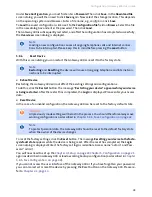
Gateway 400 User Guide | Legal Notices
52
e) Declining to grant rights under trademark law for use of some trade names,
trademarks, or service marks; or
f) Requiring indemnification of licensors and authors of that material by anyone
who conveys the material (or modified versions of it) with contractual assumptions
of liability to the recipient, for any liability that these contractual assumptions di-
rectly impose on those licensors and authors.
All other non-permissive additional terms are considered “further restrictions” with-
in the meaning of section 10. If the Program as you received it, or any part of it,
contains a notice stating that it is governed by this License along with a term that
is a further restriction, you may remove that term. If a license document contains
a further restriction but permits relicensing or conveying under this License, you
may add to a covered work material governed by the terms of that license docu-
ment, provided that the further restriction does not survive such relicensing or con-
veying.
If you add terms to a covered work in accord with this section, you must place, in
the relevant source files, a statement of the additional terms that apply to those
files, or a notice indicating where to find the applicable terms.
Additional terms, permissive or non-permissive, may be stated in the form of a
separately written license, or stated as exceptions; the above requirements apply
either way.
8. Termination.
You may not propagate or modify a covered work except as expressly provided
under this License. Any attempt otherwise to propagate or modify it is void, and
will automatically terminate your rights under this License (including any patent li-
censes granted under the third paragraph of section 11).
However, if you cease all violation of this License, then your license from a partic-
ular copyright holder is reinstated (a) provisionally, unless and until the copyright
holder explicitly and finally terminates your license, and (b) permanently, if the
copyright holder fails to notify you of the violation by some reasonable means prior
to 60 days after the cessation.
Moreover, your license from a particular copyright holder is reinstated permanent-
ly if the copyright holder notifies you of the violation by some reasonable means,
this is the first time you have received notice of violation of this License (for any
work) from that copyright holder, and you cure the violation prior to 30 days after
your receipt of the notice.
Termination of your rights under this section does not terminate the licenses of
parties who have received copies or rights from you under this License. If your
rights have been terminated and not permanently reinstated, you do not qualify to
receive new licenses for the same material under section 10.
9. Acceptance Not Required for Having Copies.
You are not required to accept this License in order to receive or run a copy of the
Program. Ancillary propagation of a covered work occurring solely as a conse-
quence of using peer-to-peer transmission to receive a copy likewise does not re-
quire acceptance. However, nothing other than this License grants you permission
to propagate or modify any covered work. These actions infringe copyright if you
do not accept this License. Therefore, by modifying or propagating a covered
work, you indicate your acceptance of this License to do so.
10. Automatic Licensing of Downstream Recipients.
Each time you convey a covered work, the recipient automatically receives a li-
cense from the original licensors, to run, modify and propagate that work, subject
to this License. You are not responsible for enforcing compliance by third parties
with this License.
An “entity transaction” is a transaction transferring control of an organization, or
substantially all assets of one, or subdividing an organization, or merging organi-
zations. If propagation of a covered work results from an entity transaction, each
party to that transaction who receives a copy of the work also receives whatever
licenses to the work the party’s predecessor in interest had or could give under the
previous paragraph, plus a right to possession of the Corresponding Source of the
work from the predecessor in interest, if the predecessor has it or can get it with
reasonable efforts.
You may not impose any further restrictions on the exercise of the rights granted
or affirmed under this License. For example, you may not impose a license fee,
royalty, or other charge for exercise of rights granted under this License, and you
may not initiate litigation (including a cross-claim or counterclaim in a lawsuit) al-
leging that any patent claim is infringed by making, using, selling, offering for sale,
or importing the Program or any portion of it.
11. Patents.
A “contributor” is a copyright holder who authorizes use under this License of the
Program or a work on which the Program is based. The work thus licensed is
called the contributor’s “contributor version”.
A contributor’s “essential patent claims” are all patent claims owned or controlled
by the contributor, whether already acquired or hereafter acquired, that would be
infringed by some manner, permitted by this License, of making, using, or selling
its contributor version, but do not include claims that would be infringed only as a
consequence of further modification of the contributor version. For purposes of
this definition, “control” includes the right to grant patent sublicenses in a manner
consistent with the requirements of this License.
Each contributor grants you a non-exclusive, worldwide, royalty-free patent li-
cense under the contributor’s essential patent claims, to make, use, sell, offer for
sale, import and otherwise run, modify and propagate the contents of its contribu-
tor version.
In the following three paragraphs, a “patent license” is any express agreement or
commitment, however denominated, not to enforce a patent (such as an express
permission to practice a patent or covenant not to sue for patent infringement). To
“grant” such a patent license to a party means to make such an agreement or com-
mitment not to enforce a patent against the party.
If you convey a covered work, knowingly relying on a patent license, and the Cor-
responding Source of the work is not available for anyone to copy, free of charge
and under the terms of this License, through a publicly available network server or
other readily accessible means, then you must either (1) cause the Corresponding
Source to be so available, or (2) arrange to deprive yourself of the benefit of the
patent license for this particular work, or (3) arrange, in a manner consistent with
the requirements of this License, to extend the patent license to downstream re-
cipients. “Knowingly relying” means you have actual knowledge that, but for the
patent license, your conveying the covered work in a country, or your recipient’s
use of the covered work in a country, would infringe one or more identifiable pat-
ents in that country that you have reason to believe are valid.
If, pursuant to or in connection with a single transaction or arrangement, you con-
vey, or propagate by procuring conveyance of, a covered work, and grant a patent
license to some of the parties receiving the covered work authorizing them to use,
propagate, modify or convey a specific copy of the covered work, then the patent
license you grant is automatically extended to all recipients of the covered work
and works based on it.
A patent license is “discriminatory” if it does not include within the scope of its cov-
erage, prohibits the exercise of, or is conditioned on the non-exercise of one or
more of the rights that are specifically granted under this License. You may not
convey a covered work if you are a party to an arrangement with a third party that
is in the business of distributing software, under which you make payment to the
third party based on the extent of your activity of conveying the work, and under
which the third party grants, to any of the parties who would receive the covered
work from you, a discriminatory patent license (a) in connection with copies of the
covered work conveyed by you (or copies made from those copies), or (b) primar-
ily for and in connection with specific products or compilations that contain the cov-
ered work, unless you entered into that arrangement, or that patent license was
granted, prior to 28 March 2007.
Nothing in this License shall be construed as excluding or limiting any implied li-
cense or other defenses to infringement that may otherwise be available to you
under applicable patent law.
12. No Surrender of Others’ Freedom.
If conditions are imposed on you (whether by court order, agreement or otherwise)
that contradict the conditions of this License, they do not excuse you from the con-
ditions of this License. If you cannot convey a covered work so as to satisfy simul-
taneously your obligations under this License and any other pertinent obligations,
then as a consequence you may not convey it at all. For example, if you agree to
terms that obligate you to collect a royalty for further conveying from those to
whom you convey the Program, the only way you could satisfy both those terms
and this License would be to refrain entirely from conveying the Program.
13. Use with the GNU Affero General Public License.
Notwithstanding any other provision of this License, you have permission to link
or combine any covered work with a work licensed under version 3 of the GNU
Affero General Public License into a single combined work, and to convey the re-
sulting work. The terms of this License will continue to apply to the part which is
the covered work, but the special requirements of the GNU Affero General Public
License, section 13, concerning interaction through a network will apply to the
combination as such.
14. Revised Versions of this License.
The Free Software Foundation may publish revised and/or new versions of the
GNU General Public License from time to time. Such new versions will be similar
in spirit to the present version, but may differ in detail to address new problems or
concerns.
Each version is given a distinguishing version number. If the Program specifies
that a certain numbered version of the GNU General Public License “or any later
version” applies to it, you have the option of following the terms and conditions ei-
ther of that numbered version or of any later version published by the Free Soft-
ware Foundation. If the Program does not specify a version number of the GNU
General Public License, you may choose any version ever published by the Free
Software Foundation.
If the Program specifies that a proxy can decide which future versions of the GNU
General Public License can be used, that proxy’s public statement of acceptance
of a version permanently authorizes you to choose that version for the Program.
Later license versions may give you additional or different permissions. However,
no additional obligations are imposed on any author or copyright holder as a result
of your choosing to follow a later version.
15. Disclaimer of Warranty.
THERE IS NO WARRANTY FOR THE PROGRAM, TO THE EXTENT PERMIT-
TED BY APPLICABLE LAW. EXCEPT WHEN OTHERWISE STATED IN WRIT-
ING THE COPYRIGHT HOLDERS AND/OR OTHER PARTIES PROVIDE THE
PROGRAM “AS IS” WITHOUT WARRANTY OF ANY KIND, EITHER EX-
PRESSED OR IMPLIED, INCLUDING, BUT NOT LIMITED TO, THE IMPLIED
WARRANTIES OF MERCHANTABILITY AND FITNESS FOR A PARTICULAR
PURPOSE. THE ENTIRE RISK AS TO THE QUALITY AND PERFORMANCE OF
THE PROGRAM IS WITH YOU. SHOULD THE PROGRAM PROVE DEFEC-
TIVE, YOU ASSUME THE COST OF ALL NECESSARY SERVICING, REPAIR
OR CORRECTION.
Summary of Contents for 400
Page 1: ...User Guide Gateway 400 ...
Page 2: ......
Page 7: ...7 11 Index 65 ...
Page 8: ...8 ...
Page 54: ...Gateway 400 User Guide Legal Notices 54 ...
Page 58: ...Gateway 400 User Guide Passwords 58 Note More Notes ...
Page 67: ......
















































